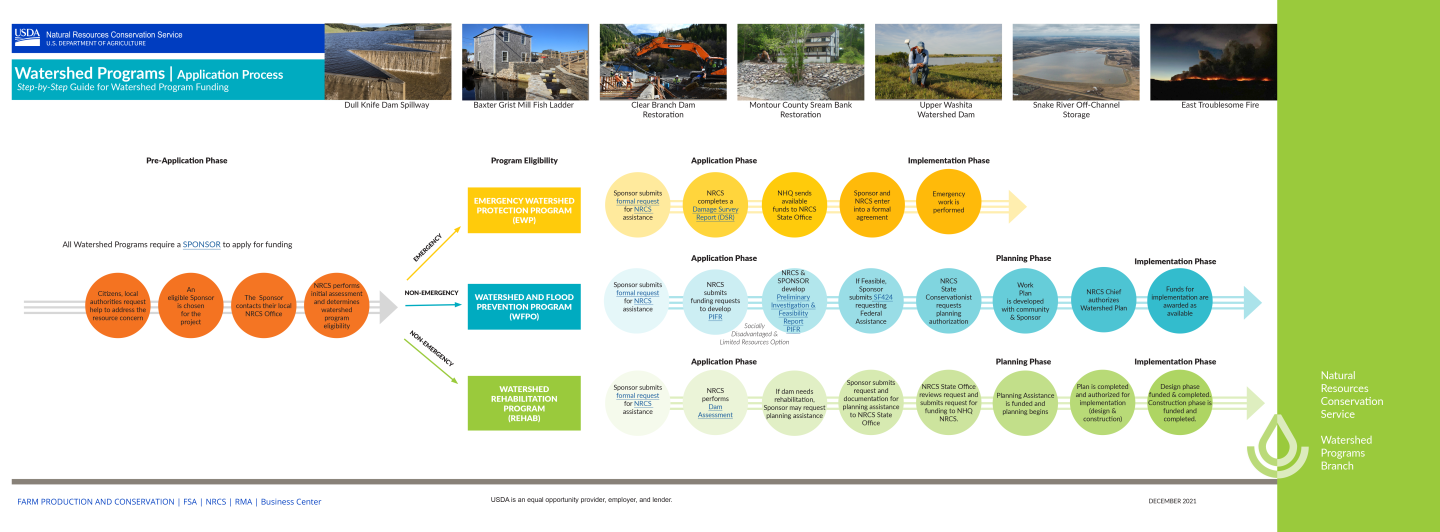
Roles and responsibilities for Watershed Programs Sponsors.

Workflow
A step-by-step guide for eligible sponsors from submitting a request for assistance thru implementation.
SPONSORSHIP BEGINS AT THE LOCAL LEVEL
Locally-led government agencies, organizations, and conservation districts understand the needs of their communities. Participation from the grassroot level on up are vital to help communities establish a resilient watershed plan that ensures a future for their towns, surrounding rural areas and other important landscapes. All Watershed Programs require a local sponsor who initiates a Request for Assistance (templates provided below) to their local NRCS office.
Below, are the sponsor requirements for both REHAB and WFPO watershed programs. Emergency Watershed Protection (EWP) Sponsor Eligibility can be found here.
Eligibility
Watershed and Flood Prevention (WFPO) and Watershed Rehab (REHAB) projects are sponsored by one or more local organizations. In essence, the sponsor acts as the fiscal agent and is responsible for initiating, supervising and maintaining the entire project as planned. For WFPO and REHAB, one sponsor MUST be able to perform at least one of the following areas of responsibility mandated by the individual state's NRCS State Conservationist (STC):
Eminent Domain
At least one Sponsor (SLO) must have the power of eminent domain. Eminent Domain is the process of acquiring real property, water, mineral, and other land rights needed for a specific project as outlined in 16 U.S.C. Section 1004 (4). Where the primary purpose of a project involves land treatment long-term contracts, the power to execute an eminent domain is not required.
Permits and Licenses
The Sponsor must be able to acquire needed permits, and licenses in accordance with local, State, and Federal laws.
Authority to Levy Taxes
This authority requirement establishes one Sponsor as the fiscal agent of the project. Meaning, they are responsible for the ‘cost share’ and financing the operation and maintenance expenses for the life of the project. Possessing the authority to levy taxes, i.e. local government agency, enables the Sponsor to finance the project as necessary with localized funding thru taxation. This authority provides financial support for the project throughout its lifetime.
Land Treatment above Reservoirs
Once a reservoir is built – the land surrounding the project is considered, and must be, part of the conservation plan. A Sponsor must be willing and able to obtain agreements from all landowners, impacted as part of a Watershed Program funded project (16 U.S.C. Section 1004 (5)), requiring implementation of soil conservation practices. All soil conservation practices must meet current NRCS Field Office Technical Guide (FOTG) criteria on at least 50 percent of the lands within the drainage area above each retention reservoir.
Watershed Projects that include land treatment practices must, at a minimum, have a Sponsor with formal soil and water conservation responsibilities inscribed in its bylaws (Articles of Organization) as required by State Law (Secretary of State).
Locally-Led Public Participation
A Sponsor must be able to create and produce effective engagement campaigns, and supporting outreach materials that encourage public participation in the watershed planning process.
Financial - Fiscal Responsibility
A Sponsor must have the ability to act as the watershed project’s fiscal agent; meaning, they will need to provide commitments for funding, demonstrate a history of project management that underscores best management practice and oversight of contracts, construction, installation, operation and maintenance of a similar project.
Watershed Management
A Sponsor must provide watershed management oversight such as permitting, zoning, land use regulations, easements, or upstream watershed protection.
Municipal and Industrial (M&I) Water
A Sponsor must provide evidence that any proposed water supply (municipal or industrial (M&I) will meet the anticipated water supply needs in quantity or quality; provide all technical services to implement M&I water supply; provide adequate assurances prior to construction that USDA will be reimbursed for at least 50% of the cost of M&I storage for the current water supply demand and 100% of all of the M&I water supply storage for any future demands.
Operation and Maintenance
A sponsor must have the power and authority to ensure the installation, operation, and maintenance of the watershed project performs as planned (16 U.S.C. Section 1004 (3)).
Storm and Sanitary Sewers
The Sponsor is solely responsible for all new storm and sanitary sewers or changes to or relocation of existing sewers or facilities. This requirement applies only to urban or built-up areas within the approved watershed project plan.
Historically, sponsorship involves local government agencies or tribal authorities who have the ability to create revenue to maintain the structure/project over its lifetime and ensure the continued protection and safety of the community it serves.
For more information, contact your local USDA NRCS Watershed Program Manager.
Additional resources for Sponsors can be found on our Sponsor Resources page.

